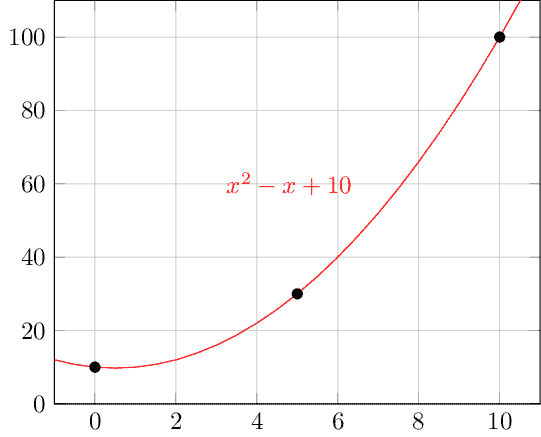1. 引言
随着数据量的爆炸式增长,如何高效处理这些数据已成为现代计算领域的重要课题。
物联网(IoT)和大数据等技术正在源源不断地生成海量数据。即便如此,我们仍可能需要在已有数据的基础上估算额外的数据。常见的一种数据格式是 XY 形式:每一个 X 值对应一个 Y 值。在这种情况下,我们可以通过插值多项式来估算某个新 X 值对应的 Y 值。
需要注意的是,多项式插值在计算机科学中有广泛应用。例如,它可以用于数据估算(与回归分析有相似之处),以及屏幕分辨率适配等场景。
本文将介绍多项式插值的基本概念。 首先,我们了解插值的基本思想;然后,学习线性插值的方法;接着,探讨二次插值的实现;最后,简要介绍其他常见的插值方法。
2. 多项式插值概述
在很多实际场景中,我们面对的是一组给定的 XY 数据样本,但并不知道生成这些数据的原始函数。当我们需要估算一个未出现在样本中的 X 对应的 Y 值时,就需要通过插值手段来估计。
在本文中,XY 数据由输入值 X 和输出值 Y 组成。X 是输入,经过某种处理后得到输出 Y。
多项式插值的核心思想是:找到一个多项式函数,使其经过所有给定的 XY 数据点。 换句话说,该函数的曲线会穿过笛卡尔坐标系中的每个点 (X, Y)。
顾名思义,插值的结果是一个多项式函数。一个 n 次多项式的一般形式为:
f(x) = a₀ + a₁x + a₂x² + ... + aₙxⁿ
给定 n+1 个 XY 数据点,存在唯一的 n 次多项式能够通过这些点。 例如,两点确定一条直线,三点确定一条抛物线。
我们的目标是找出这些多项式,并用它们来估算中间 X 值(即位于所有样本 X 的最小值和最大值之间的值)对应的 Y 值。
2.1 一个抽象示例
假设我们有三个 XY 数据样本:
| 样本编号 | 数据点 |
|---|---|
| S.#01 | (0, 10) |
| S.#02 | (5, 5) |
| S.#03 | (10, 12) |
下图展示了这三个点在笛卡尔坐标系中的位置:

接下来是通过这三个点的插值多项式曲线图:

3. 线性多项式插值
线性插值的目标是找到一条穿过两个给定 XY 点的直线。 这条直线对应的函数是一个一次多项式。
给定两个样本点 (x₁, y₁) 和 (x₂, y₂),我们希望找到如下形式的函数:
y = a₀ + a₁x
将这两个点代入该公式,得到两个方程:
y₁ = a₀ + a₁x₁
y₂ = a₀ + a₁x₂
解这个二元一次方程组,即可求得系数 a₀ 和 a₁,从而得到插值函数。
✅ 解法提示:
可以使用代入法、消元法或克莱姆法则等方法求解该方程组。
例如,解出 a₁:
a₁ = (y₂ - y₁) / (x₂ - x₁)
再代入求 a₀:
a₀ = y₁ - a₁x₁
这样我们就得到了最终的线性插值函数。
4. 二次多项式插值
二次插值的目标是找到一个二次函数(即抛物线),使其穿过三个给定的 XY 点。
假设我们有三个样本点:(x₁, y₁)、(x₂, y₂)、(x₃, y₃),我们希望找到如下形式的函数:
y = a₀ + a₁x + a₂x²
将这三个点代入该公式,得到三个方程:
y₁ = a₀ + a₁x₁ + a₂x₁²
y₂ = a₀ + a₁x₂ + a₂x₂²
y₃ = a₀ + a₁x₃ + a₂x₃²
由此形成一个三元一次方程组:
a₀ + a₁x₁ + a₂x₁² = y₁
a₀ + a₁x₂ + a₂x₂² = y₂
a₀ + a₁x₃ + a₂x₃² = y₃
✅ 解法提示:
- 可使用消元法或克莱姆法则求解该方程组。
- 求得 a₀、a₁、a₂ 后,即可写出完整的二次插值函数。
⚠️ 注意:
当三个点共线时,二次插值可能无法准确拟合,应考虑使用线性插值。
5. 其他多项式插值方法
除了上述直接求解方程的方法外,还有其他更通用的插值方法适用于任意数量的 XY 数据点。
5.1 拉格朗日插值法(Lagrange Interpolating Polynomial)
拉格朗日插值法通过构造一组基函数来构造插值多项式:
P(x) = Σ y_j * L_j(x)
其中 L_j(x) 是拉格朗日基多项式,定义为:
L_j(x) = Π (x - x_m) / (x_j - x_m) (m ≠ j)
✅ 优点:
- 形式统一,便于编程实现
- 不需要解方程组
❌ 缺点:
- 添加新点时需重新计算整个多项式
5.2 牛顿差商插值法(Newton's Divided Difference Interpolation)
牛顿插值法通过构造差商表来逐步构建插值多项式。差商定义如下:
f[x₀, x₁] = (y₁ - y₀) / (x₁ - x₀)
f[x₀, x₁, x₂] = (f[x₁, x₂] - f[x₀, x₁]) / (x₂ - x₀)
...
最终插值多项式为:
P(x) = f(x₀) + (x - x₀)f[x₀,x₁] + (x - x₀)(x - x₁)f[x₀,x₁,x₂] + ...
✅ 优点:
- 新增点只需扩展差商表
- 更适合动态插值场景
❌ 缺点:
- 实现略复杂,需要构建差商表
6. 小结
本文介绍了多项式插值的基本原理和实现方法:
✅ 关键点总结:
- 多项式插值可用于估算 XY 数据之间的中间值
- 线性插值适用于两点,二次插值适用于三点
- 拉格朗日和牛顿差商插值适用于任意数量的数据点
- 选择方法应根据具体问题、数据规模和计算资源综合判断
⚠️ 踩坑提醒:
- 插值不等于拟合,过度插值可能导致过拟合
- 高次多项式可能产生振荡,需谨慎使用
多项式插值在计算机科学中应用广泛,从数据预测到图形渲染,掌握其原理和实现方法对开发者来说是非常有价值的技能。